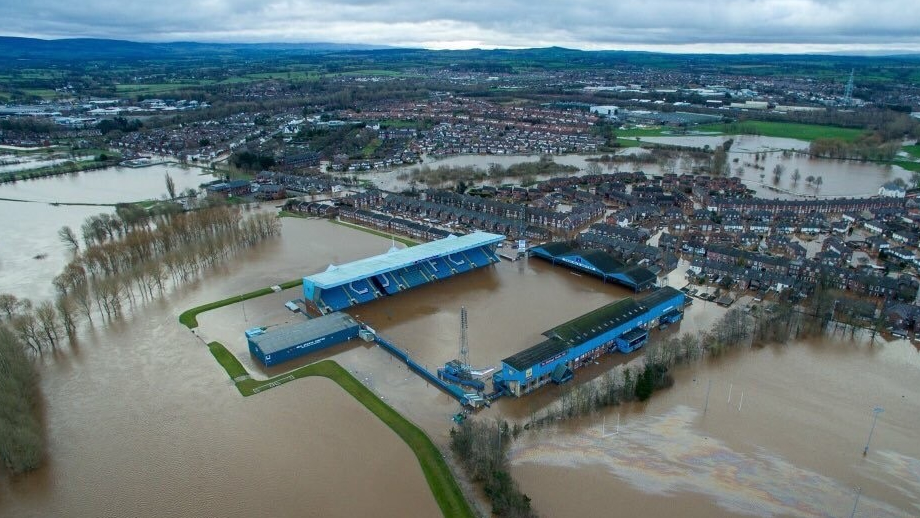COP26, held in Glasgow over the past week, has once again thrown the spotlight on the impact of climate change, not just on the world stage, but also in local communities, such as those around our own county of Cumbria, some of which face flooding events almost every year as rainfall levels continuously break records.
And here at Brunton Park, of course, we and those of us in the surrounding areas have we’ve witnessed so-called ‘one in 100-year flood patterns’ twice in the past 16 years, with all of the heartbreak, upheaval, distress and subsequent financial pain these catastrophic storms and deluges bring with them.
We’ve said this before, as bad as it is for us, we’re a football club, and nothing brings what we’re dealing with anywhere even close to what the families and people who are in it with go through as they set about the task of rebuilding their shattered lives in the wake of these terrible floods.
But what we do provide is a recognisable voice, hence the invite for chief executive Nigel Clibbens from a number of national agencies to take part in interviews and discussions designed to raise awareness of the reality of what suffering a flood really means, both when it happens and afterwards, when the after-effects and financial ramifications really do start to hit home.
You can listen to BBC Five Live climate change coverage, which has an interview with Nigel included from around 13 minutes, HERE.
Recent studies have shown that Storm Desmond, which hit Cumbria in 2015, was 59% more likely to occur because of climate change.
And using the same modelling process, by 2050 it is estimated almost one in four English Football League grounds can expect partial or annual flooding every year, as a result of sea-level rises which are again linked to climate change.
"We lost everything at first-floor level," Nigel recalled. “Both of the houses used by the players were also devastated and the repair work needed wasn’t completed until probably around October 2016, some 19-months after the flood had struck.
"Everything from the shop to the dressing rooms to the pitch had been affected. From a financial viewpoint the significant impact we found was that when we came to renew our insurance, we were almost uninsurable.
“The excess was huge on the only cover we did get and the cap had been reduced. We have an unfunded insurance gap now. The club is having to self-insure that and carry the risk."
An obvious solution would be – as many people have told the club – to relocate and leave the threat of flooding behind.
“Before the flood in 2015, the club was looking to relocate," he added. “The normal model is to sell the existing land, but the value of our land is very uncertain.
"Anybody who knows Carlisle knows that our stadium would come under the banner of 'very traditional'. It is a 1950s-style stadium in desperate need of investment to bring the facilities up to modern standards and to meet the expectations of fans.
"The flood risk around us and the impact on the value of the site, be it to help us secure investment or acquire value for relocation, has been all-but destroyed by flood risk.
“That undermines our ability to develop the club and be resilient, coupled with an insurance risk hanging over us and the threat of the situation getting worse in generations to come.
“What we have now is that we hold our breath, waiting to see if another flood comes, and even our ability to be somewhere else is out of our control now as people are waiting to see if the flood defences work.
“Going back to insurance, even though the work has gone into the defences, our premiums are still going up. It does not help us to help ourselves. How do you redevelop and progress with that shadow across a flood bank?"
With rainfall levels already high through late summer and early Autumn, fingers are crossed that the new defence system will work, and that Brunton Park will be able to relax more when the ‘flood alert’ texts start to ping out of the ether.
“A number of us get these alerts and, having been through the worst-case scenario before, it does cause real concern,” he explained. “If you pardon the pun, when the river levels are visibly already high it becomes ‘all hands to the pump’ as we make sure anything that can be moved is taken up a floor, above the historical flood levels, as soon as those alerts arrive.
“We all know first-hand how hard it hits when it happens, so we do whatever self-help we can … but there’s only so much you can do.
“The hope is that the EA work that has just been completed will mean that Carlisle is better able to cope, but we will only know for definite when the next onset of heavy rainfall arrives.
“And with the climate change models suggesting that things will only get more testing, we also have to hope that the defences will give protection for even heavier rainfall that’s predicted to come.”

